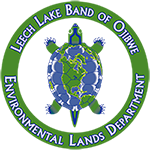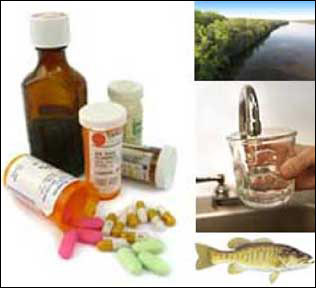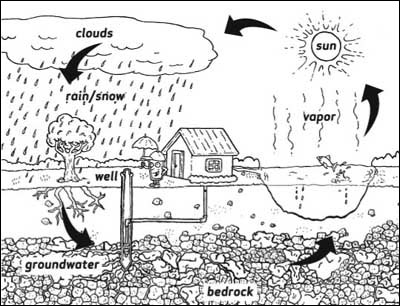 What You Can do
What You Can do
TOPICS:
1. REDUCiNG TOXINS IN OUR HOME
2. SEPTIC SYSTEM MAINTENANCE
3. EARTH-FRIENDLY CLEANING IDEAS
4. WATER CONSERVATION METHODS
5. PHARMACEUTICALS IN OUR WATER

1. Reducing Toxins in Our Home
Simple changes in our everyday routine can reduce our long-term exposure to low levels of potentially harmful substances- changes in how we choose products we buy, changes in the way we clean our houses, changes in how we take care of our yard. These changes will not only make our homes safer, they may also save us money.
Household Chemicals
• Be aware that many chemicals commonly used around the home are toxic. • Select non-toxic or less toxic alternatives.
• Buy chemicals only in the amount you expect to use, and apply them only as directed. More is not better.
• Take unwanted household chemicals to hazardous waste collection centers; do not pour them down the drain. Pouring chemicals down the drain may disrupt your septic system or else contaminate treatment plant sludge.
• Never pour unwanted chemicals on the ground. Soil cannot purify most chemicals, and they may eventually contaminate runoff.
• Use low-phosphate or phosphate-free detergents.
• Use water-based products whenever possible. Select biodegradable products which are also less toxic.
• Choose pump sprays instead of aerosols, since aerosols contain volatile organic compounds.
Other Areas Where You Can Make a Difference
• Clean up after your pets. Pet waste contains nutrients and pathogens that can contaminate surface water.
• Drive only when necessary. Driving less reduces the amount of pollution your automobile generates. Automobiles emit tremendous amounts of airborne pollutants, which increase acid rain; they also deposit toxic metals and petroleum byproducts into the environment. Regular tune ups and inspections can help keep automotive waste and byproducts from contaminating runoff. Clean up any spilled automobile fluids.
• Recycle used oil and antifreeze by taking them to service stations and other recycling centers. Never put used oil or other chemicals down storm drains or in drainage ditches. (One quart of oil can contaminate up to two million gallons of drinking water!)
Reducing toxics in your bathroom
• Avoid using anti-bacterial soaps. Antibacterial agents are not directly harmful to you, but they contribute to the growing problem we face when bacteria mutate to strains that are more drug resistant.
• Look for unbleached paper products or products bleached with hydrogen peroxide or oxygen, which produce less pollution during papermaking. Using paper without chlorine helps avoid the introduction of dioxins into our environment
• Use eye drops, contact lens solutions and nasal sprays that are free of thimerosal or other mercury-containing preservatives.
• Look for unscented and natural dyes in products
• Don't flush pharmaceuticals down the toilet. These products will end up down stream and affect fish and wildlife. Wastewater treatments do not always have the facilities to treat these human by-products and therefore will be discarded into our water. For example, even low levels of ibuprofen, steroids and antibiotics can block fin re-growth in fish.
Alternatives to keeping your house clean
• Single ingredient common household materials, such as, baking soda, vinegar or plant-based soaps have been shown to keep surfaces as free of bacteria as antibacterial soaps.
• Baking soda works well to clean sinks, tubs and toilets and it freshen drains as well.
• Vegetable oil with a little lemon will clean wood furniture.
• Simmer a mixture of cloves and cinnamon as a natural air freshener.
• Use vinegar and water in a spray bottle for cleaning mirrors and windows.
• Use dishwater detergents that are free of chlorine bleach and lowest in phosphates.
Reducing toxics outside
• Test your soil fertility before applying fertilizer to your yard. Excess phosphorus and nitrogen will only create excess algal blooms in our near lake and rivers.
• Consider replacing parts of your yard with native perennials that lower maintenance and lessen the need for water and chemicals.
• Never dump unwanted chemicals down your drain, so these do not get into our water ways.
• Compost your yard waste
• Check your car for leaks, and recycle motor oil
• Have your septic tank pumped and system inspected regularly.
2. Septic System Maintenance
More than 25 percent of Minnesota households use septic systems to treat their wastewater. A septic tank has 4 main functions:
• Separates solids from liquid
• Bacteria decompose organic solids
• Septic tanks store other solids until removed by pumping
• Delivers liquids to soil treatment area
Improperly maintained septic systems can contaminate ground water and surface water with nutrients and pathogens:
• Inspect your septic system annually.
• Pump out your septic system regularly. (Pumping out every three to five years is recommended for a three-bedroom house with a 1,000-gallon tank; smaller tanks should be pumped more often.)
• Do not use septic system additives. There is no scientific evidence that biological and chemical additives aid or accelerate decomposition in septic tanks; some additives may in fact be detrimental to the septic system or contaminate ground water.
• Do not divert storm drains or basement pumps into septic systems.
• Avoid or reduce the use of your garbage disposal. (Garbage disposals contribute unnecessary solids to your septic system and can also increase the frequency your tank needs to be pumped.)
• Don't use toilets as trash cans! Excess solids may clog your drain field and necessitate more frequent pumping.
Improperly treated sewage can impact human health and the environment:
• Sewage backup into your house
• Water or sewage surfacing in the yard
• Sewage odors indoors or outdoors
• High levels of nitrates or coliform bacteria in your well water
• Algae blooms and excessive plant growth in nearby ponds or lakes
• System failure is a common result from improper design or installation, overuse of water in home and lack of proper maintenance.
3. Earth Friendly Cleaning Ideas
Americans spend millions of dollars a year on cleaning supplies and it is so easy to make your own. The recipes are friendly to the environment and to your bank account.
Countertops, cupboards and walls
Dip a cloth in warm water; add dish soap and baking soda, (the baking soda serves as a soft abrasive to remove tough spots and light scratches).
All-purpose cleaning spray
1/2 tsp. washing soda
a dab of liquid soap
2 cups hot tap water
Combine the ingredients in a spray bottle and shake until the washing soda has dissolved. Apply and wipe off with a sponge or rag.
Bacteria, mold and germs spray
Supermarket vinegar (5% solution) kills 99% of bacteria, 82% of mold and 80% germs. Spray on bathroom and kitchen surfaces.
Air fresheners
Simmer a small amount of cinnamon, orange peel, and cloves on the stove to give off a pleasant fragrance in your home.
Window/ glass cleaner
¼ cup white vinegar
½ tsp. liquid soap
2 cups of water
Put ingredients in a spray bottle
Carpet freshener
Sprinkle dry cornstarch or baking soda on your carpet and vacuum.
Rug stains
Rub borax into dampened area, let dry, then vacuum or repeatedly blot stain with a mixture of vinegar and soapy water.
Mildew build-up
Make a paste of vinegar and salt and apply to built-up area.
Furniture polish
Combine 1/2 cup lemon juice to 1 cup vegetable oil, olive oil, or mayonnaise.
Oven cleaner
1 cup or more baking soda, water
a squirt or two of liquid detergent
Sprinkle water generously over the bottom of the oven, then cover the grime with enough baking soda that the surface it totally white. Sprinkle some more water over the top. Let the mixture set overnight.
Floor cleaner
1/8 cup liquid soap, ¼ to ½ cup white vinegar or lemon juice, ½ herb tea, combine ingredients in pail with 3 gallons of warm water. Swirl until it is sudsy. Rinse with 1 cup of vinegar in 3 gallons of cool water.
Unclog drains
Sprinkle a generous amount of baking soda in and around the drain opening. Follow with a cup of white vinegar. Repeat if needed, and finally flush with very hot water.
Toilet bowl cleaner
1 cup borax
½ cup white vinegar
Let sit for several hours
4. Water Conservation Methods
Homeowners can significantly reduce the volume of wastewater discharged to home septic systems and sewage treatment plants by conserving water. The average American uses 60 gallons of water daily to wash, flush, bathe and to do laundry.
Examples:
-Household faucet: 4 gallons/ minute
-Shower: 4-11 gallons/ minute
-Toilet: 5-7 gallons/ flush
-Dishwasher: 15-25 gallons/ load
-Washing machine: 35 gallons/ load
Alternative solutions:
• Use low-flow faucets, shower heads, reduced-flow toilet flushing equipment, and water saving appliances such as dish and clothes washers.
• Repair leaking faucets, toilets, and pumps.
• Use dishwashers and clothes washers only when fully loaded or buy a water saver device or hand wash dishes.
• Take short showers instead of baths and avoid letting faucets run unnecessarily.
• Wash your car only when necessary; use a bucket to save water. Alternatively, go to a commercial carwash that uses water efficiently and disposes of runoff properly.
• To reduce water consumption in your bathroom, add weighted plastic bottles to tank or remodel with a low flow flush toilet.
• Drinking water: Keep cold water in frig instead of running water for a cold drink or use ice to cool.
5. Keeping Pharmaceuticals/Wastewater Contaminants Out of Our Waterways

Pharmaceuticals and personal care products (PPCPs) are comprised of various chemicals substances, which eventually enter the environment through wastewater that can not be treated at a sewage treatment plant. The two main ways that PPCPs reach our lakes and streams is by the excretion of partially metabolized pharmaceuticals by human bodies and the disposal of unused or expired medications down the sewer. Wastewater treatment plants are designed to remove conventional pollutants, such as suspended solids and biodegradable organic material, but not designed to remove low concentration of synthetic pollutants (pharmaceuticals). In addition, synthetic compounds are designed to be resistant to biological degradation.
Most of the PPCPS found in waste water include antibiotics in humans and livestock, mood altering drugs, compounds found in birth control pills, over-the-counter therapeutic drugs, cosmetics, sun-screen agents, shampoo, antibacterial soaps, perfumes and bug spray (deet). PPCPs are an emerging issue and quite complex due to their chemical composition, environmental transport and fate. Some chemicals will go through photolysis (break-down by sunlight), hydrolysis (a chemical reaction in which water reacts with a compound to produce other compounds), biodegradation, transformation, absorption into sediments, diffusion and dilution into our waters.
Moreover, these compounds pose risks to both aquatic organisms and potentially humans. Emerging contaminants interact with hormone receptor cells. Their action can not be distinguished from that of our bodies’ natural hormones. Some examples include: the inability of males to reproduce in fish, spawning patterns, acute toxicity (death) in aquatic organisms and interference with the endocrine system (hormone production).
In general, tribes are disproportionately impacted by chemical contaminants in the environment through their resource use practices relating to traditional life ways. The impact to tribes when tribal resources are contaminated extends beyond impacts to human health and the overall ecosystem to larger issues of tribal culture, spirituality and lifestyle.
Most harmful chemicals in effluent from U.S. streams (USGS):
• ethynylestradiol (birth control pills)
• nonylphenol and alkylphenols (used in detergents, degreasers and deicers).
• bisphenol-A (makes plastic pliable)
• perfluorchemicals (telfon)
• DDT (this chemical was banned, but still exists in different forms)
• triclosan (anti-bacterial soaps)- creates bacteria resistant organisms
• industrial effluents
• pesticides and herbicides (runoff from farmland)
More Information
http://toxics.usgs.gov/pubs/FS-027-02/
http://www.pca.state.mn.us/publications/w-hw4-45a.pdf
LINKS
How to dispose properly of your unwanted pharmaceuticals:
http://www.pca.state.mn.us/oea/hhw/pharmaceuticals.cfm
Contact Us
(218) 335-7400 DRM
| Name | Title | Phone |
|---|---|---|
| Brown, Levi | Environmental Director | 335-7417 |
| Harper, Jeff | Water Resources Program Manager | 335-7415 |















 Division of Resource Management
Division of Resource Management